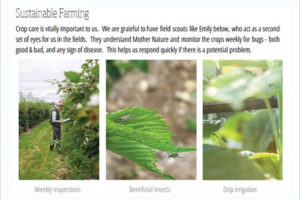Don’t Miss Opportunities to Market Your Biocontrol Program

NatureFresh Farms emphasizes on its website how and why its Bug Brigade uses beneficial insects and biological control agents, with easy-to-understand terms and education.
I have seen some incredible examples of people using biocontrols, but unfortunately, they don’t tell anyone about what they’re doing or why. The use of biopesticides, beneficial insects, and predatory mites is one of the best stories that we can share with our customers and the public. So why aren’t more of us doing it?
Currently, the agriculture industry is faced with an image problem. Ornamentals producers took the brunt of this on the frontlines as the most immediately consumer-facing industry dealing with the neonicotinoid issue. The industry came under fire when neonicotinoid pesticides were claimed to cause a decline in pollinator health.
It started with a massive bee kill due to the misuse of product on some flowering trees at an Oregon shopping mall that went public, leading to widespread consumer protests and spurring NGO (non-governmental organizations) groups to commission research testing plants for pesticide residues on pollinator plants.
From protests at big box stores to rants on social media, consumers haven’t been afraid to speak out about their thoughts on pollinator health. One has only to Google “Neonic protests” and you’ll see endless images of protesters in bee costumes standing outside of home improvement stores and garden centers, and Tweets and Instagram posts sounding off on pollinator health.
Their collective voices protesting the use of neonicotinoids have been so loud and adamant that big box retailers have given into the pressure and required their plant suppliers to tag, reduce use, or eliminate the use of neonicotinoids altogether. For example, The Home Depot has mandated that growers phase out neonics on plants by the end of 2018, and Lowe’s growers are required to cut out neonics by the end of 2019.
Do Consumers Actually Care?
According to recent research from scientists at Michigan State University (Heidi M. Wollaeger, Kristin L. Getter, and Bridget K. Behe) on “Consumer Preferences for Traditional, Neonicotinoid-Free, Bee-Friendly, or Biological Control Practices on Floriculture Crops,” the answer appeared to be no.
The research found that the latest important factor in the ranking of stated importance was that no neonicotinoid insecticides were used during the production of the plant, and 57% of all study participants reported they did not understand the term.
This vastly conflicts with claims by NGOs like SumOfUs that polling shows American consumers want corporate retailers to eliminate neonics.
In the MSU study, the top decisions to purchase plants were plant species (41%), production type (33%), and price (26%). For the subjects who viewed the outdoor plants, “bee-friendly” and “use of beneficial insects” had greater economic value. The terms “neonicotinoid-free” and “traditional insect control” both had negative scores, indicating they were valued less and detracted from the dollar value of the plant.
How Do We Communicate Our Efforts?
If consumers don’t actually care about neonicotinoid use, will they care about our biological control practices? Will they see our efforts to use biocontrols as an indictment of conventional methods?
Preliminary indications tell us consumers want to buy plants grown with biocontrols. Yet there is still so little information available because the industry has done little to educate consumers and retailers about our practices. We need to develop widespread messages that will communicate our efforts to the masses, and provide more perspective from the industry.
Here are some examples of growers who are doing this right.

Krause Berry Farms does a good job of openly communicating with its customers about its crop protection methods through social media platforms such as Instagram.
NatureFresh Farms is one of the largest independent greenhouse produce growers in Canada, as well as one of the largest greenhouse bell pepper growers in North America. It’s based in Leamington, ON, and over the past few years has constructed 45 acres of greenhouses in Ohio. This grower is super active online and with social media, very cleverly promoting its group of growers known as The Bug Brigade, and telling the story of how it is using beneficial insects and biological control agents. The operation uses positive, easy-to-understand terms like “good bugs” to communicate how and why it is using biological control agents and beneficials, and why consumers may see bugs on their plants. NatureFresh also does a good job of introducing scientific terminology by educating consumers on the names of the insects and what they do to help plants grow naturally. The operation even has a coloring book and resources for school-age kids and educators.
Krause Berry Farms and Estate Winery is a working destination farm that grows 200 acres of berries and vegetables in Langley, BC. On its website, the operation explains its outlook on crop protection, saying that a complete elimination of crop protection is unrealistic in the short term, and explaining its integrated pest management practices. Considerations include beneficial insects, biopesticides, and conventional pesticides, and the farm adheres to province and national requirements for safe application.
Sunset Farms, based in Kingsville, ON, operates thousands of greenhouses across North America. Its cucumbers are sold in grocery stores nationwide, where it promotes its Green Grass Project on its packaging. This includes greenhouse products grown with integrated pest management practices (IPM).
Nadine Stielow, who owns Thiel’s Greenhouses in Alberta, Canada, operates 50,000 square feet of growing space where she produces hydroponic vegetables. Stielow is learning and constantly posting videos on social media about her journey into using biocontrols, so her customers are learning right along with her.
Other retail and commercial growing operations are starting to do a good job with posting signs in their stores to educate consumers and employees on these newer pest control methods. You will see signs about why there are sachets in the plants, as well as the banker plants and what they are for. In the retail setting, banker plants have to be labeled that they are not for sale with an explanation why so they are not sold. This has generated massive interest and buy-in from their customers.
There is so much more that can be done if our industry would just take the initiative, be a little creative, and show our customers just how far we have come.










